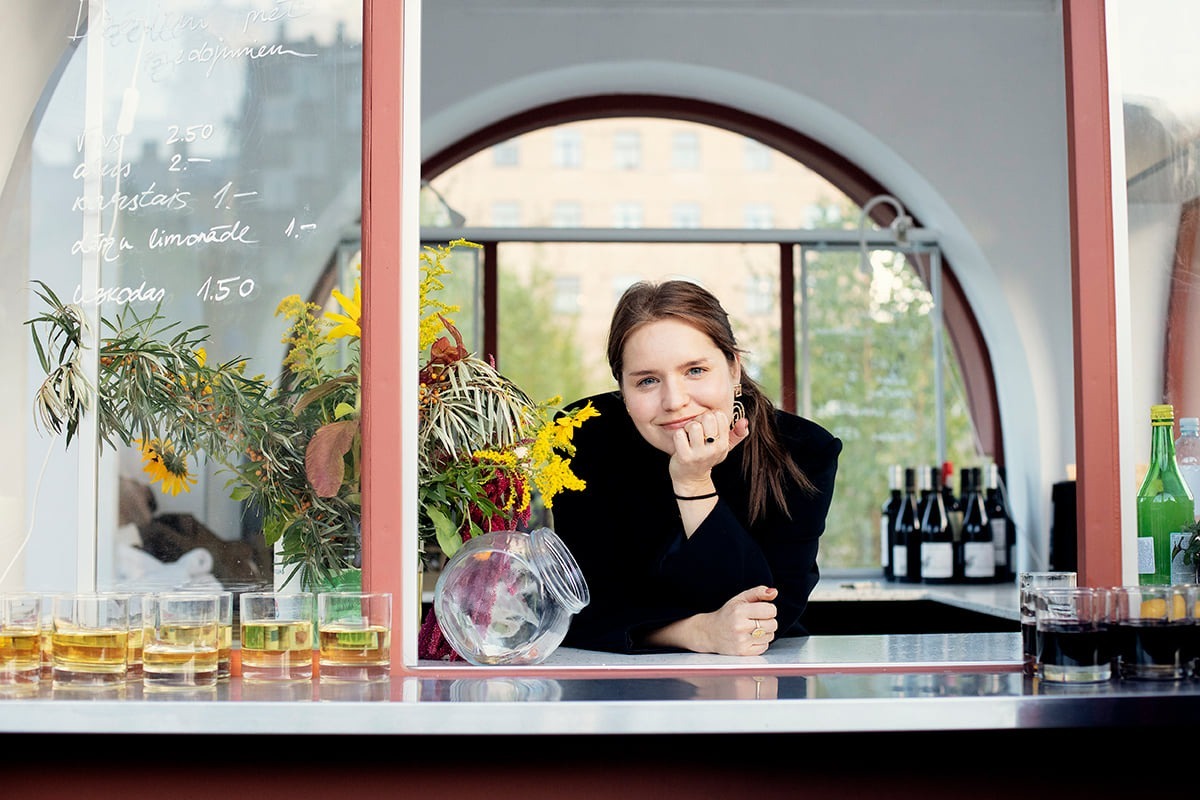
Anticipating a Sun for All
A conversation about ‘the discreet charm of eclecticism’ with the 2023 Purvītis Prize candidate Daria Melnikova
This is not the first time that Daria Melnikova (Darja Meļņikova) has attracted the interest of the most important visual arts award in Latvia, the Purvītis Prize (PP). Her ‘Palette’ project was nominated for the prize in 2021. The artist described her project in the following way: ‘When I am invited to present a solo exhibition, I propose to mount it in a way that is similar to a set rather than in the classical format – as a specific ambience featuring works by artists invited by me. I would be like a ‘conductor’ orchestrating all of this.’ The project started its journey in 2019 in Prague, at the Karlin Studios Gallery, and then travelled to Marseille where it was presented as part of the Manifesta 13 official collateral programme in autumn 2020. ‘This installation, in my opinion, is an excellent example of the artist’s ability to adjust herself to a new world order (overproduction, shifting boundaries) and the current turbulent situation where the joy of meeting people is the most valuable thing of all, and also place a special emphasis on hospitality – not just as part of the art practice but also as a new strategy for rehabilitation of the humanity,’ member of the Purvītis Prize panel of experts, art curator Elīna Sproģe explained her decision to nominate Melnikova in winter 2021.
‘The permanent element in the ‘Palette’ project or, as I call it, ‘the catering business’, is represented by a bar counter (slash art object) behind which I prepare special drinks that somehow tie in with the theme and the current location of the exhibition,’ Daria said in 2020. The story resulted in an adjacent project by Daria, ‘The Kiosk’, an actual kiosk built back in the 1980s, toward the end of the Soviet era, in the Sports Palace Gardens (Sporta pils dārzi), renovated and moved to the centre of one of the most surreal places in the whole of the city. This abandoned space in the city centre has remained empty since 2008 when the Sports Palace complex of buildings was demolished. Since 2020, a local gardening community has taken over; the gardeners have each been given an allotment, a small piece of the territory, and a number of special boxes for growing plants. The Kiosk has found its place amidst the allotments, in a small grove of very young birch-trees that have emerged from the ground here. Cold and hot drinks and snacks are sold there; occasionally it also hosts various art projects. Daria’s Kiosk will reopen this summer.
Daria Melnikova. The Anticipation, 2021. Solo exhibition at the gallery 427, Riga. Photo: Līga Spunde 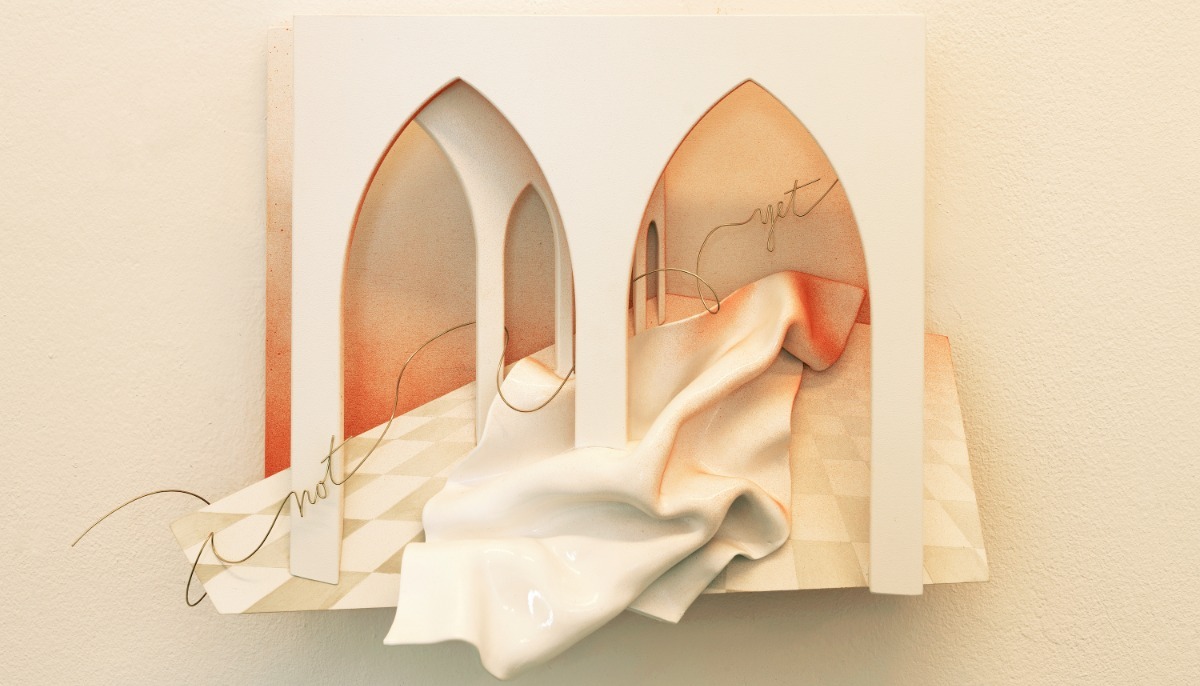
The latest, 2023 Purvītis Prize nomination, as well as the next stage – taking part in the exhibition of works by the shortlisted artists at the Latvian National Museum of Art – however, are not related to the Kiosk. May 2021 saw Daria open her solo exhibition at the well-known 427 Gallery in Riga, a venue consistently focusing on innovative and experimental art; the show was entitled ‘The Anticipation’. It was this project that caught the eye of the Purvītis Prize panel of experts. ‘In Daria Melnikova’s exhibition, the actual gallery space transforms into an idea. It is an idea for a harmonious, balanced space with clear and clean proportions and reduced elements of the symmetry and layout borrowed from classical architecture. Once again, Daria Melnikova has managed to subtly merge the contemporary with references to historical art movements (Renaissance, Gothic, metaphysical art) and, similarly to the way the perspective historically changed the way we view the world, completely transform the space beyond recognition,’ member of the 2023 PP panel of experts Līna Birzaka-Priekule explained her decision.
Daria Melnikova. The Anticipation, 2021. Solo exhibition at the gallery 427, Riga. Photo: Līga Spunde 
Indeed, perfectionism and a knack for crystallizing her own territory, writing her own rule book – these two important qualities characteristic of Daria are manifested most convincingly here. Daria is not trying to solve global problems (according to her own words), but she does manage to create small, intense, precisely and subtly set up oases of contact and beauty, shimmering with meanings, lightyears away from any kind of visual banality.
We spoke with Daria about her ways of achieving that and her vision of a ‘Sun for All’ (the title of her recent show in Palermo, in Sicily) – from different rooms in different countries.
Where are you right now?
In Italy, at an art residency; it is called Palazzo Monti; it is in Brescia.
It’s a palace then?
Yes, an actual palazzo. The family that owns the palazzo renovated the building and set up an art residency. As per the best Italian traditions: a family just owns a palazzo.
Did you take part in a competition to get selected?
Yes, I submitted an application last year; I waited and I waited, and it finally happened.
Why did you choose a place in Italy specifically?
I generally have a special fondness for Italy, and my most recent projects have contained lots of references to Renaissance, to Italian art. And I often travel to Italy because it inspires me and nourishes me.
That’s what I thought when I remembered your 2023 Purvītis Prize-nominated show at the 427 Gallery – that it makes a lot of sense.
I may have inherited it from my mum. I remember when she travelled to Italy in the 1990s; the trip lasted two or three weeks, and my sister and I waited for her to come home impatiently and then listened to her stories, mouth agape. And so Italy became this land of my dreams.
Is it the outlook on life, the local traditions that you can relate to so well? What is it that speaks to you in this country?
It is, of course, obvious that I am from a Northern country in comparison with Italians; their life is so relaxed: a coffee every half-hour, all sorts of breaks. Last year, when I was installing my exhibition in Palermo, in Sicily, I thought I would tear my hair out because nobody was doing anything much or trying too hard. Eventually you get used to it, you accept it and start to realize that they may actually be right: do we really need extra stress in our life? But what I find congenial is probably a whole set of various qualities and things, the climate, the fragrant southern air, the architecture. I generally find inspiration in the city, in the external shell of urban life – the layout of the city, the design of the buildings, the particular blend of styles. And Italy is a country that has struck a particular chord with me – with its colours, its tonality, the way its natural colours blend with the urban ones, creating not a vivid palette but rather a ‘powdery’ toned-down, calm one, the colours forming a long range of tonal grades. And, of course, the sun, the blue sky. I feel good here. But it’s also nice to be back in Latvia – in the summer, in warm weather. (Laughs)
Daria Melnikova. The Anticipation, 2021. Solo exhibition at the gallery 427, Riga. Photo: Līga Spunde 
When you were thinking about your show at the 427 Gallery, you were preparing it here, in Riga?
Yes, and it was custom-designed for the 427 Gallery specifically: I wanted to transform the place so that people would enter and not recognise the space. The space is small, and then there’s the fireplace: it is beautiful, of course, but you can grow a bit tired of it; it is, after all, an active element of the room, a contributor to every exhibition taking place here. That is why the first thing I wanted to do was to somehow cover the fireplace. And not just put a wall or a partition in front of it but create actual new architectural elements. And that was how it all started.
So in a way you built your own ‘ideal city’ inside the gallery?
Yes, that’s why I love building sets: you create your own city, your own world, and you do whatever you please there. Whatever you can dream up.
Daria Melnikova. The Anticipation, 2021. Solo exhibition at the gallery 427, Riga. Photo: Līga Spunde 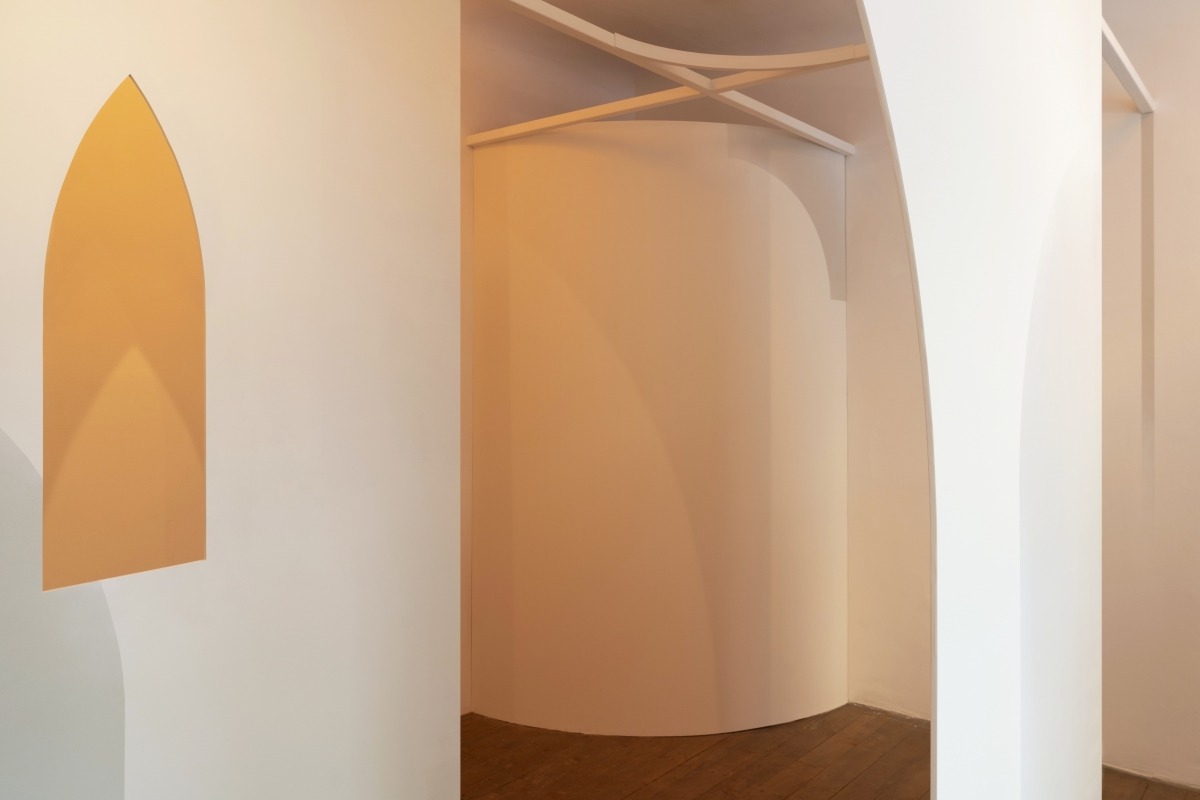
But that’s a city without people, pure architecture…
What I am creating is something like a shell, after all. The people that come and visit, they are the ones who fill it with life.
And how did the people look within this space?
The whole exhibition, frontally looking, was made up of several planes that interplayed between themselves like elements of a collage. And when people came in, there was always someone behind one wall so that only his or her head was visible through the opening. And somebody else was in the foreground, but since the walls were irregular, they also looked like an element of a collage. Somebody’s head was visible, a part of somebody else’s arm, and so on.
The Anticipation, 2021. Solo exhibition at the gallery 427, Riga. Photo: Līga Spunde 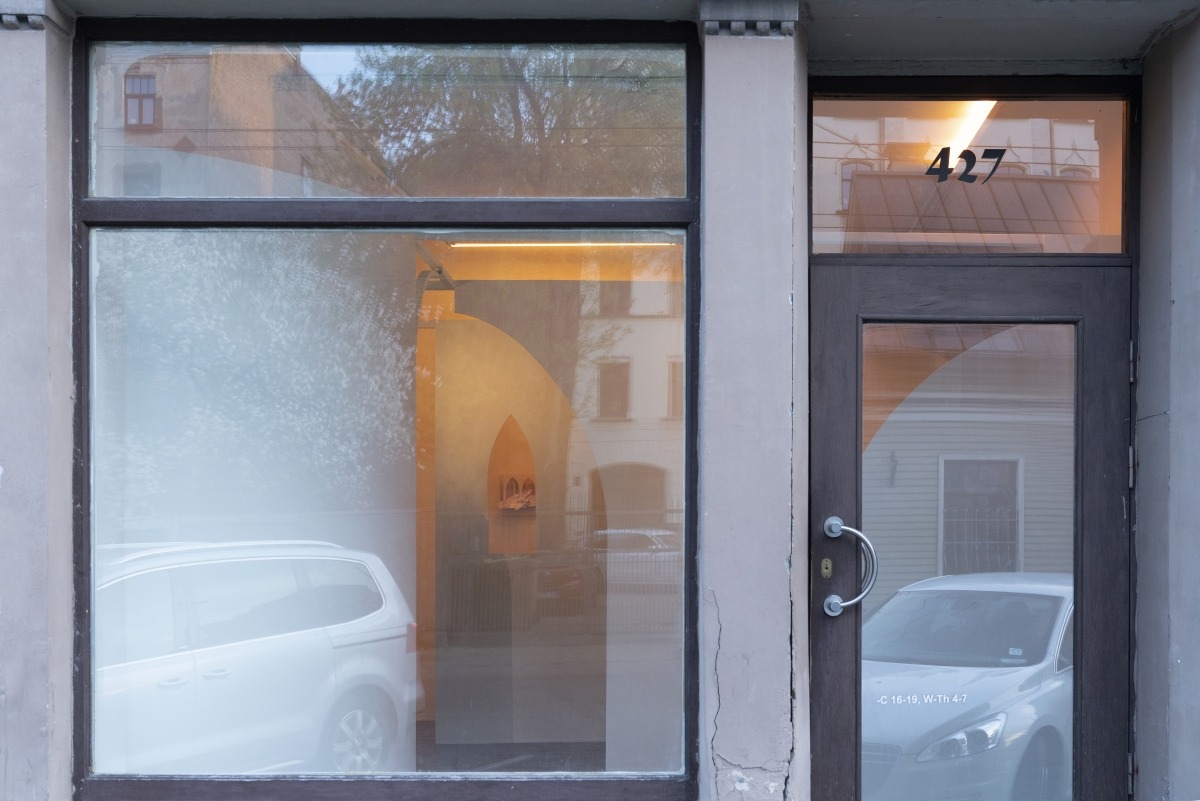
What is your take on the title of the show, ‘The Anticipation’, and the phrase that is literally included in the exhibition, ‘Not Yet’?
The idea of the exhibition was to transfer certain architectural elements to the realm of senses. For instance, you are walking down an arcade, and, since the arcade is the same throughout the length, it is monotonous, and your eye starts to skip the repetitive details and focus on moving forward. And it occurred to me that walking down an arcade is actually like anticipation. Something may take place – but perhaps it will not. It is like the horizon; when you walk, you seem to be approaching it. But are you ever going to reach it? In terms of historical references, I also compare this to the transition from the Gothic to Renaissance. That is why there are gothic arcades present in the exhibition. Renaissance in this context is something that is yet to come, the anticipated. If we look at the art of the time, it was the time when artists first started to depict perspective. Until then, perspective was completely absent in the visual arts.
What about the Not Yet thing?
The phrase extends the state of anticipation by an indefinite stretch of time. It is an equivalent of an arcade but a verbal one.
Daria Melnikova at her solo show 'Palette' at Karlin Studios - Prague, 2019. Photo: Tomáš Souček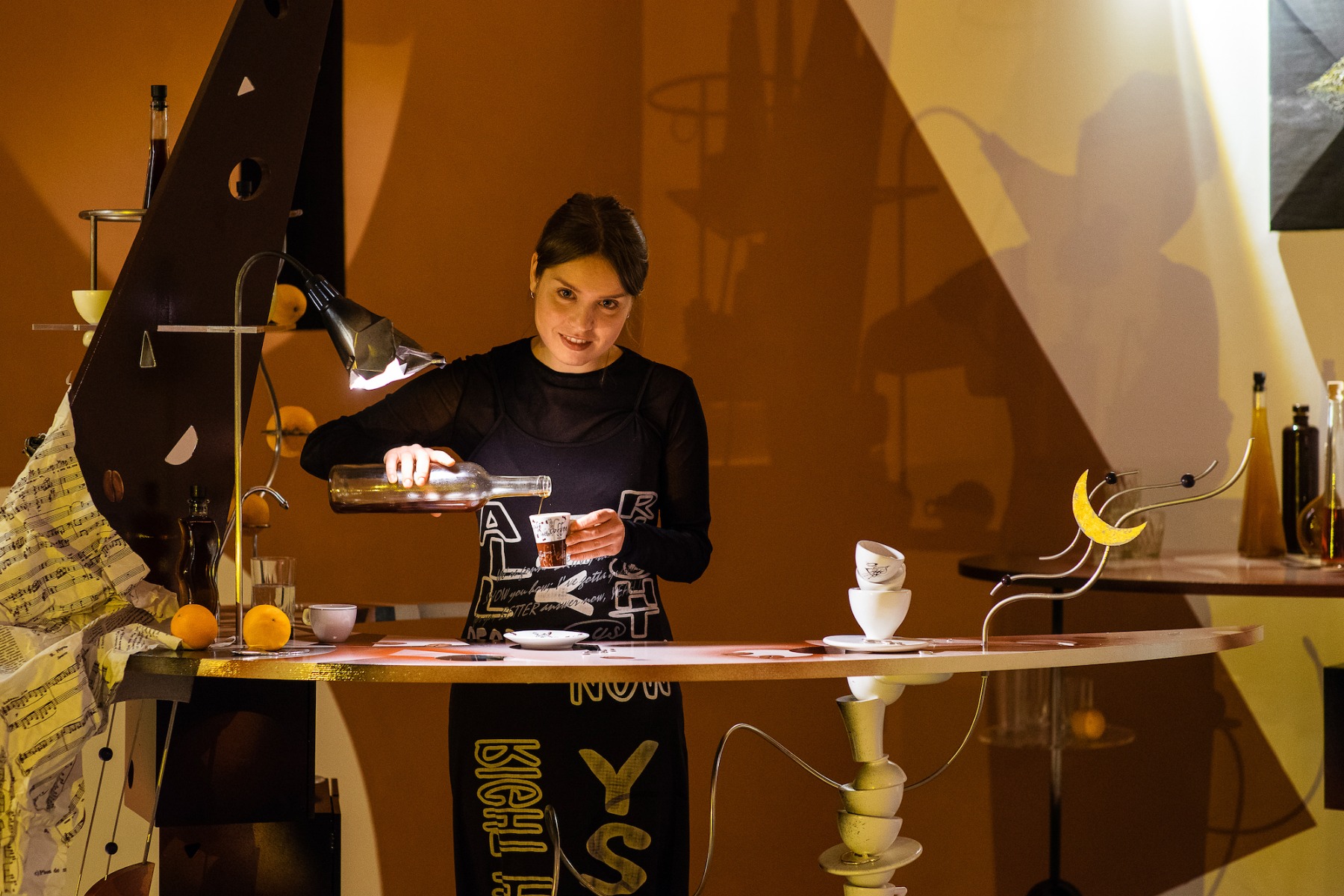
An exquisitely presented one! When we last spoke – in 2020 – you were working on your ‘Palette’ project. Do you still find it interesting?
Sure; it is going on view in Helsinki in April. In Riga it somehow morphed into the Kiosk. Looks like this is going to be the last summer for the Kiosk: the territory that was home to the allotments has already been sold. However, over the last two years the Kiosk served as a seasonal headquarters for the idea behind ‘Palette’. It is not just a café/bar in an ‘interesting place’ but also a platform for collaboration; for instance, last summer it hosted the ‘summering’ exhibition by the French artist Kamil Bouzoubaa-Grivel featuring his textile works, flags, and a gastronomic event by the ‘conceptual cook’ Monika Varšavskaja, ‘The Treat’. Monika is from Estonia but she also currently lives in France.
Yes, I attended the second event… That was fantastic.
I’m not sure about this summer as yet; it is not at all easy to combine manning the Kiosk and organizing events.
Киоск Palette, Сады Дворца спорта, Рига. Фото: Madara Kuplā
So you literally spent the entire summer in this little kiosk?
Yes, I’m the bartender, the barista, the manager and the dishwasher. (Laughs) And also when someone comes and asks, ‘How is this an art project’, I have to tell them how and why. Actually, I wanted to create a place in Riga that was not meant for any particular kind of audience – not just for artists, not just for people with low income, or quite the opposite. I wanted everyone to feel good in this strange little wood in the middle of the city, amidst the birch-trees. Like a cultural spot.
What is your personal takeaway from this experience as a barista, dishwasher and landlady of the Kiosk?
I like being with people, socializing. But when it’s just you, doing everything all at the same time – it is difficult. I only work four days a week, it might seem that three days off is a lot. But they fly by… You spend the first day acclimating yourself after your workdays, then you work on the menu, and then you must do the shopping. I don’t have any kind of pantry space there, I can’t store three months’ worth of provisions, so just about every other day I do a run to the wholesalers, the farmers’ market, the shops.
What has it taught me? A bit of tolerance, I guess. And an understanding of the hellish amount of work that is done by people who run these public spaces. And sometimes you have to smile when you really don’t want to. And be polite, and calmly brush off so much. But, on the other hand, good reviews are very motivating, they cheer you up and help you to keep going.
It will be a pity if it really closes after this summer. I have given it so much, made it nice for myself to be in there. Because it is very important to me – when I’m working, the atmosphere has to be right, or I won’t be able to concentrate.
Where did you initially find this kiosk?
I bought it on Facebook Marketplace. It was located in Olaine, brought there by some people who wanted to open a summer café by the local lake. But the Olaine city council said it did not fit the landscape and told them to get rid of it. So it was taken to a car park, where it just stood unused for a year or so. Because even moving this kiosk from one place to another means booking a special vehicle with flashing emergency lights, since it exceeds some sort of size parameters. And this is very expensive.
And what will happen to it next? In the autumn?
I think and worry about it, of course. But I don’t have my own patch of land where I could put it – in the city or anywhere else. So its future is as yet undetermined, but there is still some time. It could be sold on, of course, but I fear I might get jealous – someone using my kiosk to sell belyashi pasties?! I really would not want it to become associated with some kind of burgers or kebabs.
Yes, it’s unlikely to be bought by another artist… And what are you going to show in the Helsinki ‘Palette’?
This will not be a solo project, it is a group exhibition. The curators asked me to exhibit the bar counter – the core of ‘Palette’ – and hold a performative event: invent some drinks that would tie in with the location, something Scandinavian. So I am going there early, to take some time and think of what I am going to offer the visitors. There is also the possibility of playing around with the scenography. This I will also decide when I get there. To sum it up, it's going to be a bar in the middle of a group exhibition of other artists’ works that have been selected by the curators of the exhibition. That is, not like before, at the two previous sessions of ‘Palette’, where I chose the surrounding artists myself. In both cases I was initially invited to hold a solo exhibition, which meant I had complete freedom in choosing to invite any other artist. And I could arrange the entire space, its scenography and the placement of the other works to my liking. Helsinki is going to be different, but interesting as well – as an adaptation of the project to the setting of a group show.
I’ll Find You in the Garden / The Adoration of Flora. 2021
What direction are your new works taking?
Of course, I’m still pursuing the interests I already had. But I strive to make each new work better than the last. Currently I am doing things on a smaller scale, like small installations that are quite complex and make use of various materials and techniques and their combinations. This approach is new to me and takes a lot of experimentation. My works are not quite miniature – the format is A2 or A3 – but they are multi-layered, which gives the compositions texture and volume. They are reminiscent of the exhibition at the 427 Gallery, but a little flatter… if you imagine the gallery as a box and then squash it a bit. I use wood, metal, plastic, fabric, ceramics and plaster, paper and painted trompe l'œil elements. It’s eclectic, but in a modest, not-too-loud way. Yes, modestly eclectic, I don’t even know if that’s possible – but I try to make these works harmonious.
I made three such works back in the year before last, but it so happened that no-one got to see them, they went to a private collection immediately after the art fair. The ones I am making now – I am hoping these will be even better.
Daria Melnikova. The Sun for All, 2022. Solo exhibition. L’Ascensore, Palermo. Photo: Filippo M. Nicoletti
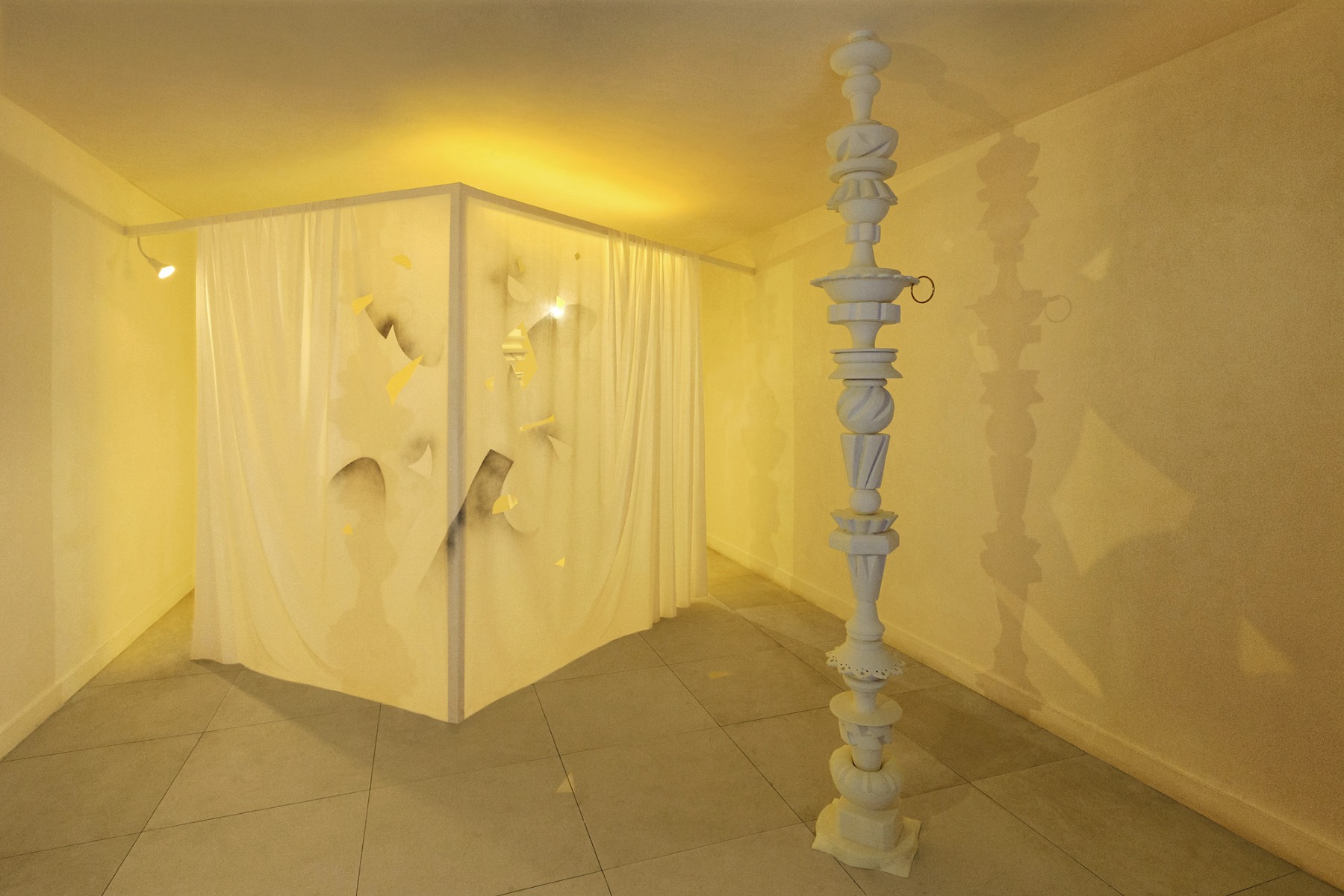
How were you and your plans affected by the past year – the year when a full-fledged war started in Ukraine?
I was in Palermo when it all started, my exhibition opened on the first day of the war. And I spent the following day reading news, I read myself into a fever, I even fell sick… It is incomprehensible. And it is still going on… I had no projects connected to Russia, I didn’t have to drop anything. But I had thought of inviting some Russian artists to take part in one of the ‘Palette’ sessions. This would absolutely not be possible now – no way of getting any financing. All my artist acquaintances have left Russia, they roam the world, get turned away from everywhere; they are treated with quite a lot of prejudice, I do feel sorry for them, too.
Can an artist somehow influence the current situation?
I don’t think they can right now. These things are being decided on other levels. We are pawns in this situation.
But what is the overall role of your art in the world? What are you doing with your art in this chain of interactions of which our world consists?
I am not solving any global problems with my art. My works are like notes – little comments on everyday life. Trying to prove something to someone, to impose my point of view – no, that is not what I am about.
The show that opened in Palermo on the day the war began was called ‘The Sun for All’. When the sun rises, it rises for everyone; it does not segregate, it unites. So later, in view of everything, I thought this might be taken as some kind of a political comment. But I did not intend it as such. I have a series of works in which I explored the subject of communal spaces that reflect the habits or trends of a particular social stratum. But in general, I don’t normally emphasize any social message or commentary.
Palette: Three-Legged Evidence (Ep 2), 2020. Solo exhibition with invited artists at the Salon du Salon, Marseille. Photo: Philippe Munda
You may call them notes, but I would say your works are very clear and thought-provoking models – examples that show you can be contemporary yet also try to think in an emphatically harmonious, even Renaissance-like way… (They laugh)
Yes, I am so fond of that era. It was a golden age of craftsmanship. The world we live in now is more digital. Fewer and fewer people have the skill and desire to create ‘unique objects’ with just their hands and their wits, without the interference of high technologies and the influence of Pinterest. But I am very interested in the ways they used to do these things – in mastery of all kinds, in all fields, and not just art. The art of that era, be it portraits or still lifes, provides very detailed depictions of interiors. And you can see what used to be trendy, what tiles they used. What’s on the table, what’s hanging on the wall, what fabric prints they favoured. All these things are notes on an era. And I also make such notes. Works that link together the past and my current experiences.